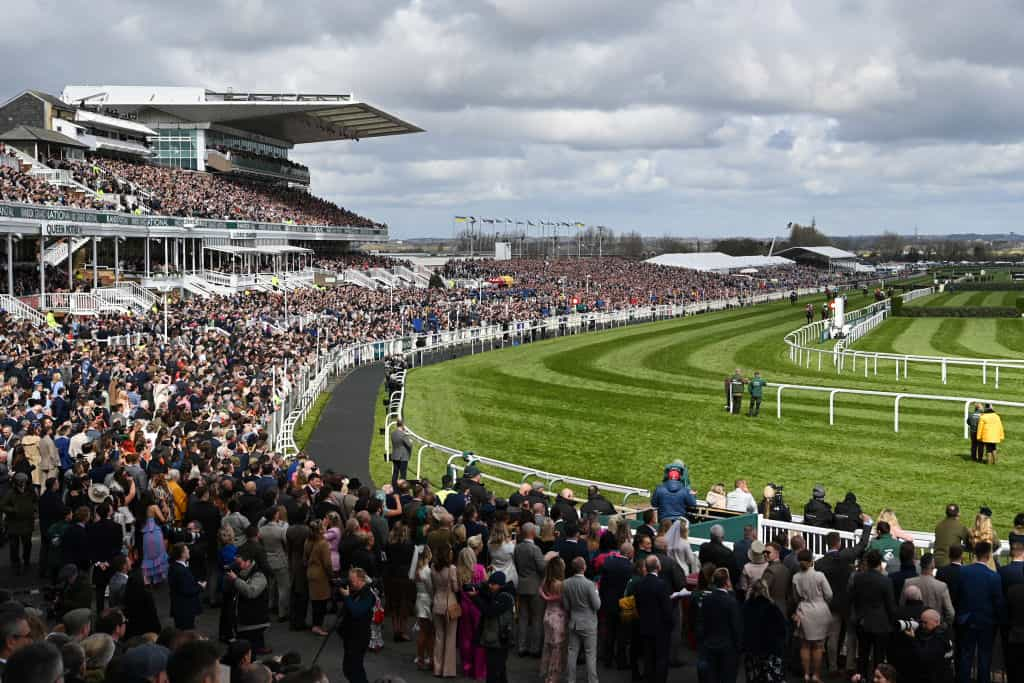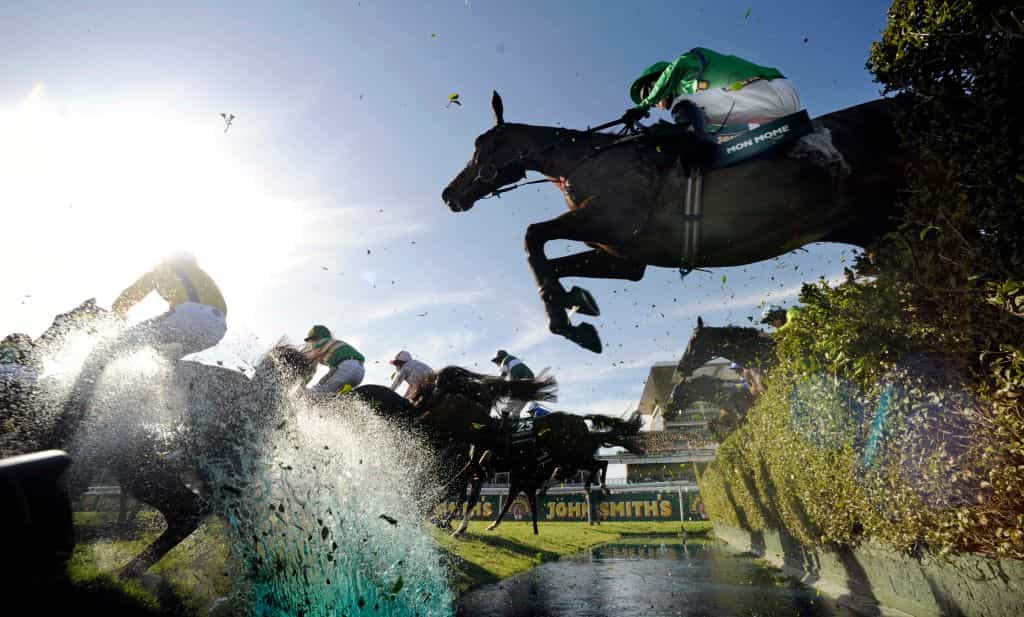Five of the Grand National’s Biggest Priced Winners
The Grand National is part of the fabric of British society. In the UK, over £100 million is gambled on the famous race every year. Domestically, ten million people will watch the contest live. It is believed one-third of the English, Northern Irish, Scottish and Welsh adult population place a bet on the Aintree marathon every April.
Globally, an estimated 600 million people watch the race, and since recently betting sites which accept £10 bets also cover the event. Little wonder the spectacle is declared the “world’s most famous steeplechase”. Everyone from royalty to racing drivers and Hollywood A-listers has attempted to own or ride a Grand National winner. But National winners are hard to come by, and during the past 40 years, just four outright favorites have prevailed.

Around 150,000 fans attend the three-day Grand National Festival – making it one of the biggest horse racing events on the planet. ©GettyImages
Despite the four-mile two-furlong course being safer and less demanding than ever before, the average starting price of a Grand National winner during the past few decades is over 25/1.
Possibly the biggest Grand National upset of all came in 1967 when Foinavon won the race at odds of 100/1. But the Grand National winners list shows five previous winners have scored at those treble-digit odds. Read on as we look at five National winners that floored punters at big odds.
Foinaven: The Most Dramatic Grand National Winner
The 1967 Grand National appeared a wide-open affair. Four horses amongst the 44-runner field shared favoritism at odds of 100/8. And punters would have been hopeful as the bulk of the fancied runners – and all 28 remaining runners – cleared the enormous Becher’s Brook (fence number 22) on the second circuit.
But, what Pathé’s commentator described as the “most incredible pile-up of all time” was about to happen at the 23rd fence. A loose horse, Popham Down, swerved before the field at the obstacle – the smallest on the course at four feet and six inches – hampering the leaders and causing a mêlée that saw every runner refuse, fall, or unseat its jockey.
There was one exception, Foinavon. Jockey John Buckingham managed to negotiate a clear passage around the chaos and, scrambling over the obstacle, progressed from being tailed off to holding an advantage of almost a furlong.
Try as they might, 17 horses and their remounted jockeys could not catch the horse that had traded at 500/1 on the eve of the big race. Tote punters were rewarded with odds of 444/1, but it is doubtful Foinavon’s connections benefited from the remarkable return. Neither his owner nor trainer attended the Grand National meeting believing their charge had no chance!
Ben Nevis: Had a Mountain to Climb
Like Foinavon, 1980 Grand National winner Ben Nevis was named after a Scottish mountain. And, at 40/1, he was the biggest-priced Grand National winner since the 1967 scorer. The starting price suggests his victory was a shock but, unlike his predecessor, Ben Nevis had good form in the book.
Bred in England, Ben Nevis was sold and sent to America after limited success point-to-pointing. Stateside, he had won eight races, including the Maryland Hunt Cup twice. The contest is a four-mile slog featuring 22 timber fences.
A bid at the 1979 Grand National under the care of trainer Tim Forster followed. Far from dismissed by the betting public, the 11-year-old traveled well until being brought down at the 15th fence under his American amateur rider Charlie Fenwick whose day job was merchant banking.
Twelve months later, carrying four-pound less and racing on a heavy surface, Fenwick and Ben Nevis avoided his rivals by taking the lead at the start of the second circuit. He was never headed thereafter and scored by 20 lengths. Notably, only four of the 30 runners completed the race.
When Ben Nevis died in 1995, aged 27, he was buried alongside the 13th fence at the Grand National course in Butler, Maryland.
Last Suspect: As the Odds Suggest
Between 1967 and 2009, the biggest-priced Grand National winner was the 1985 scorer Last Suspect. Like Ben Nevis and 1972 Grand National winner, Well To Do, Last Suspect was trained by Tim Forster. Last Suspect also raced in the yellow colors – with a black band, black cap, and gold tassel – of Arkle’s owner, Anne Duchess of Westminster.
Following a bright start to his career, Last Suspect had become stubborn, unreliable, and disinterested in racing. On the outing before his Aintree appointment, the seemingly regressive 11-year-old was pulled-up in an ordinary Warwick chase.
It took the persuasion of jockey Hywel Davies to secure the 50/1 shot’s place in the 1985 Grand National. Neither owner nor the trainer was keen on his chances in a strong renewal of the race. The field included 1983 Grand National scorer Corbiere, 1984 winner Hallo Dandy and West Tip, who went on to win the 1986 National.
1985 Grand National: Eventual winner, Last Suspect, on the far-left just clearing Bechers pic.twitter.com/nX3xCADZEv
— Sports & Betting History by BestBettingSites (@CDCHistory) April 8, 2021
Given a striking ride, Davies kept the truculent Last Suspect sweet by steering his temperamental mount wide throughout. After a juddering mistake at the third last, Last Suspect jumped the final obstacle in fourth position. But, with his tail flashing in disapproval, he consented to pass two rivals and collared the eventual runner-up, Mr. Snugfit, less than 50 yards from home.
Red Marauder: Wins a War of Attrition
The 2001 Grand National, won by a 33/1 shot, Red Marauder, was memorable for several reasons. Contested on bottomless-ground, the race was won in a pedestrian 11 minutes – almost two minutes slower than the previous and consequent National scorers. It was the slowest winning time in over 100 years.
The heavy conditions seemingly contributed to at least one horse falling at every fence ahead of the eighth fence – the relatively small Canal Turn. At this point, in a scene reminiscent of Foinaven’s 1967 National, a loose horse swerved and caused pandemonium.
Resultantly, 10 horses refused, were brought down, or unseated their riders. Approaching the 19th fence, only three horses remained galloping, and that number became two when the top-weighted Beau refused.
Two from home Red Marauder passed the eventual runner-up, Smarty, to win the race by an official ‘distance’ margin. Eventually claiming third and fourth – also punctuated by a ‘distance’ – were the Tony McCoy-ridden Blowing Wind and the 2020 Grand National winner, Papillon.
Both horses had been remounted following their refusal at the 18th. Only four horses finished the race. Famously, that number could have been five, with jockey Carl Llewellyn borrowing a mobile phone from a spectator to call his mount’s trainer seeking permission to remount his horse and complete the course!
Mon Mome: No Bog and No Mêlée
The first and only 100/1 winner of the Grand National since Foinaven, Mon Mome’s 2009 victory did not happen as a result of a mêlée or bog-like conditions. He did not arrive at Aintree with a recent pulled-up effort or confusing overseas form. And, unlike Foinaven he was not racing off bottom weight carrying considerably more than he would in a normal handicap.
Just four months before his Grand National victory Mon Mome had beaten 14 rivals in a Cheltenham Listed Chase. On his next outing, he started favorite for the Welsh Grand National – a race previously won by Grand National winners Silver Birch, Bindaree, and Earth Summit.

Mon Mome and Liam Treadwell mid-flight at the water jump in the 2009 Grand National. ©GettyImages
However, two well-beaten efforts on soft and heavy going before the 2009 Grand National meant punters dismissed his chances racing with a lofty 11-stone. Mon Mome and his rider, Liam Treadwell, were unaware of their apparent slim chances (his Tote return was 157/1), and they crept into contention from the rear after clearing the water jump.
Jumping well throughout, Mon Mome – the first French-bred Grand National winner in 100 years – was amongst 15 horses clustered together heading towards the penultimate fence. But, heading 2008 Grand National winner Comply or Die after the final jump, the nine-year-old outstayed his rivals and romped away to a 12 lengths success before muted but packed grandstands.
Mon Mome, trained by Venetia Williams – who became only the second female to win a Grand National – raced a further 18 times before his retirement at the age of 13. He never won another race but did finish third in the 2010 Cheltenham Gold Cup.



